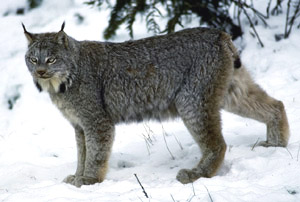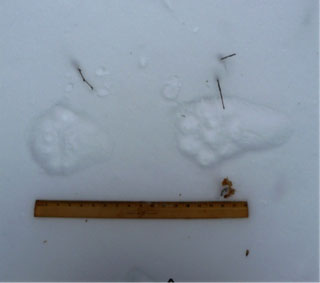Read the Vermont Fish and Wildlife press release here.
See the story of Fox/ABC news here.
There was lot of other coverage locally, but no additional information.

Read the Vermont Fish and Wildlife press release here.
See the story of Fox/ABC news here.
There was lot of other coverage locally, but no additional information.
 A trapper killed a lynx in northern Idaho earlier this month, thinking it was a bobcat, the Coeur d’Alene Press reports. He immediately called state wildlife officials when he realized his mistake, the article says.
A trapper killed a lynx in northern Idaho earlier this month, thinking it was a bobcat, the Coeur d’Alene Press reports. He immediately called state wildlife officials when he realized his mistake, the article says.
The animal was trapped just outside a region in northern Idaho that the U.S. Fish and Wildlife Service had designated as critical habitat for the species listed as federally threatened. Even so, the CDA Press article says, lynx are rare in the region. The article says:
“Losing a lynx to trapping or any other cause is disheartening,” said Jim Hayden, Idaho Fish and Game regional wildlife manager for the Panhandle region. “Fortunately these are very rare events.”
Bobcats and lynx are similar looking, the article notes. Lynx have much larger feet and have fur between their foot pads.
Read the Coeur d’Alene Press article here.
This month’s Wildlife Express, a school newsletter from the Idaho Fish and Game Department focuses on lynx.
Photo: lynx in snow from USFWS
 There are lynx sightings in Vermont and a new bobcat management plan in New York.
There are lynx sightings in Vermont and a new bobcat management plan in New York.
In New York, the bobcat management plan offers a road map for managing the species over the next five years. Bobcat numbers in the state are up, the report says:
All indications, including harvest trends, suggest that bobcats have increased in abundance here and in surrounding states, and observations have become more common in recent years. Based on analysis of harvest data, we estimate New York’s bobcat population to be approximately 5,000 animals in areas where regulated hunting and trapping seasons have been in place since the 1970s. Estimates are not available for populations expanding into western and central New York.
Because of this, the plan includes opening some new areas of the state to bobcat hunting and changing the bobcat hunting season in other areas for the sake of consistency. The report also mentions investigating the possibility of reestablishing bobcats on Long Island, in the urban southeast corner of the state.
In Vermont, it’s the rural northwest corner of the state that is seeing an increase of lynx sightings, according to the blog of the US Fish and Wildlife Service’s Northeast Ecological Services.
A total of eight lynx track intercepts were recorded during two survey efforts in February and March. The track patterns and genetic analysis indicated three to five distinct individuals, some of which were traveling together.
The animals traveling together were likely a mother and her young, the blog says, which suggests a breeding population in the area.
Read the entire blog post, here.
Photo: Lynx track, courtesy Vermont Fish and Wildlife Department
 The first Canada lynx in Idaho in over 15 years was inadvertently caught in a leg-hold trap, the Idaho Department of Fish and Game said on Tuesday.
The first Canada lynx in Idaho in over 15 years was inadvertently caught in a leg-hold trap, the Idaho Department of Fish and Game said on Tuesday.
Read the article in the Chicago Tribune, here. The Idaho Dept. of Fish and Game release is here.
Elsewhere in the West, The Denver Post says that:
“Federal lawyers have backed away from fighting a federal judge’s ruling that favors lynx, clearing the way for possible broader protection of the quick-pawed predators in Colorado and other Western states.”
Read the whole article in The Denver Post, here.
Meanwhile, in New Hampshire, there is evidence that the state’s lynx population is growing. (Growing from zero to something, maybe.) Read the blog entry in the Concord Monitor, here.
In Maine, they have so many lynx (600-1,200) that keeping them out of bobcat traps is becoming a problem. Recently, six lynx were trapped and another was killed. Read the story in the Bangor Daily News.
Lynx photo courtesy US Fish and Wildlife Service
A paper in the current issue of the Wildlife Society Bulletin says that when gray wolves are removed from an ecosystem, Canada lynx populations take a double blow. One blow comes when elk and deer populations explode and eat all the shrubs. That leaves the lynx’s prey, the snowshoe hare, with nothing to eat and no where to hide.
The other blow is that without wolves maintaining the “ecology of fear,” coyote populations also increase. And while coyotes will eat anything, they really like to eat rabbits, hares and other creatures of that size. In places where deep snow pack does not keep the coyotes away, lynx can find themselves with little to eat.
Yes, this is yet another example of mesopredator release, but as the pithy Science news article (subscription required) points out, in Canada they have both wolves and lynx. In the U.S. there are places without wolves where lynx have suffered a mysterious decline. It will be interesting to see what happens to lynx populations in places with growing wolf populations.
Read the Oregon State University press release here.
Read an article in the Minneapolis Star Tribune here. And here’s a write-up from the East Oregonian.
Photo: Canada lynx, courtesy of Oregon State University